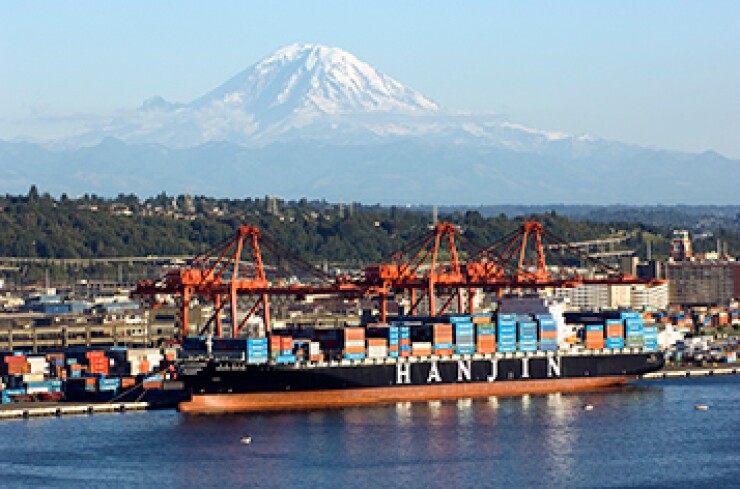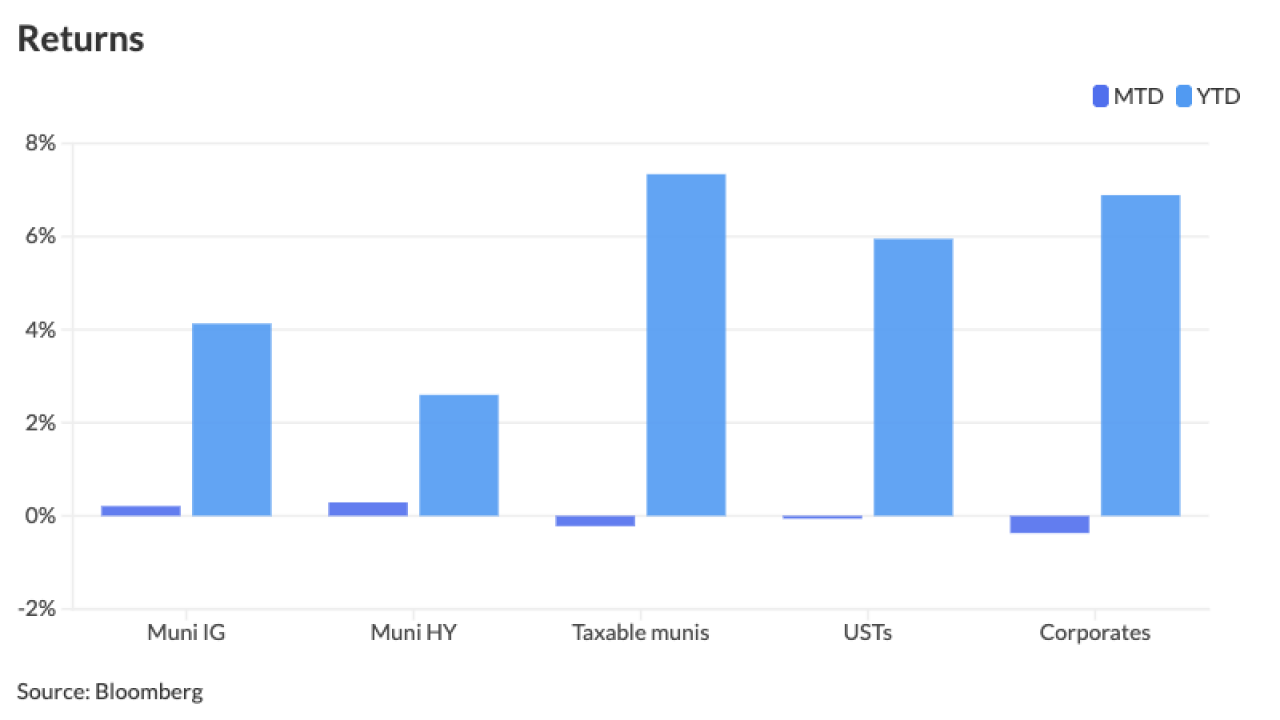
SAN FRANCISCO – The ports of Seattle and Tacoma have merged their marine cargo operations in an effort to better compete with other Pacific ports while keeping their bond portfolios independent.
The two port commissions voted Aug. 4 to approve forming the Northwest Seaport Alliance, as they and other west coast ports angle to avoid losing business to ports in Mexico, Canada, or even other regions of the United States. The two Washington ports made the move to coordinate the handling of freight through both while avoiding duplicate capital investments.
The new port development authority will not issue bonds, and each will remain separately responsible for issuing new debt.
The Tacoma port had about $400 million of revenue bonds outstanding at the end of 2014, according to financial disclosures posted on the Municipal Securities Rulemaking Board's EMMA website. The Port of Seattle, with operations that encompass the large Seattle-Tacoma International Airport, has more than $2 billion of revenue debt outstanding.
The Tacoma-Seattle alliance is now the third-largest trade gateway in North America, the Federal Maritime Commission said, behind the ports of Los Angeles and Long Beach and the Port of New York/New Jersey.
Smaller, regional seaports cannot process the larger vessels that will begin passing through the expanded Panama Canal next year, and analysts have said some ports could lose business as companies move to the new ships. The so-called Panamax ships can be up to 1,200 feet long and 160 feet wide, and are capable of carrying 13,000 of the 20-foot long cargo containers. U.S. seaports currently capable of handling the larger ships are Seattle and Tacoma, Los Angeles, Long Beach, Oakland, and the Atlantic ports of Norfolk, Va., and Baltimore. Projects under way will open up the ports in Miami, Houston, and New York/New Jersey to the deeper-draft vessels.
The Northwest Seaport Alliance announced Oct. 19 that it is moving forward on another infrastructure project to make Seattle’s Terminal 5 “big ship ready,” but has determined that additional environmental review is required by the State Environmental Policy Act.
“Upgrading Terminal 5 to handle larger vessels is critical to creating new maritime and industrial jobs for the region,” said Stephanie Bowman, co-president of the Port of Seattle. “As part of our commitment to the community, we will carefully study the environmental impacts of the terminal improvements.”
The planned dock improvements will accommodate heavier cranes and provide deeper drafts to handle the larger ships cascading into the trans-Pacific trade. Terminal 5 could only handle ships with a capacity of 6,000 20-foot-equivalent units (TEU) when container operations were suspended in July 2014 to allow for the strategic investments necessary to handle two 18,000-TEU ships simultaneously. Design and permitting began last year.
The Alliance said its new partnership will strengthen the ports’ competitiveness in an environment when larger ships from Asia will now have the option of passing directly through the expanded canal, and federal lawmakers from the area and by Washington Gov. Jay Inslee have lauded the partnership .
But analysts are mixed on whether the joint venture will provide significant benefit to the ports’ bottom lines. In its most recent report on the Port of Seattle, Standard & Poor’s emphasized the importance of Seattle-Tacoma International Airport, which the port owns. The airport accounts for the majority of the port's gross revenue, generating 76% of the $535 million in revenues that the Port of Seattle produced in 2014, the port’s chief financial officer said in July.
S&P also noted that Seattle would maintain its cruise ship terminals independently of the alliance.
“In our opinion, the formation of the alliance is credit neutral,” the rating agency said.
Emma Griffith, a director in Fitch Ratings’ Global Infrastructure group, said she views the alliance as a neutral development from a ratings standpoint for the Port of Seattle, but as a positive from a business standpoint. The ports were formerly fierce competitors, she said, and no longer focusing on battling each other should be a benefit.
“They can now focus on getting that discretionary cargo through their gateway instead of trying to one-up each other,” Griffith said.
Thomas Schuette, senior vice president and co-head of credit research at Gurtin Fixed Income Management, said his firm has been watching the situation carefully and believes the operational merger has “mixed implications.”
“In the near term, we believe this will be modestly positive for each port given the very competitive environment amongst U.S. and Canadian west coast ports, Schuette said. “Competing for cargo volume as a unified entity makes practical sense – though the alliance does not really materially change the competitive landscape each port was facing. However, over the longer term we believe the new alliance may carry some risks given that each port retains its own publicly elected board that must answer to taxpayers in each respective jurisdiction and each port retains ownership of its respective assets. So this new alliance creates a potential political hurdle to future boards that may look unfavorably towards evenly splitting net revenues and capital contributions with a neighboring jurisdiction, especially if one of the two ports is seen as a weaker partner in the future. Getting each board to agree on the best approach to future capital spending and upgrades may prove daunting. So in some respects, the new alliance creates an extra layer of complexity and risk for bondholders.”
Management of all west coast ports earlier this year managed to settle a labor dispute with the 20,000-member International Longshore and Warehouse Union, which represents workers at 29 ports including Seattle and Tacoma. The dispute stoked fears that more shippers would be enticed to divert cargo away from the west coast, but the long-term impact may not yet be known. Through September, the NWSA announced Oct. 19, the alliance has handled nearly 2.8 million TEUs and is on pace to top last year’s 3.4 million TEUs.





